Search the Special Collections and Archives Portal
Search Results

Transcript of interview with Thomas Barbarite by Dennis Chamberland, March 3, 1981
Date
1981-03-03
Archival Collection
Description
Dennis Chamberland interviews Thomas Barbarite (b. 1932) in his home about his time in Las Vegas and his experiences in the casino industry. Barbarite discusses his time at the Four Queens and the Dunes as a dealer as well as his work as a pit boss at the Flamingo, the Aladdin, and Caesars Palace. Chamberland also asks Barbarite about the changes over time on the Strip, including the disappearance of lounge shows and expansion of larger shows on the Strip. Barbarite also discusses the involvement of the mob in Las Vegas, particularly the influence of Bugsy Siegel in the operation of various properties.
Text

Transcript of interview with Mildred Bardy by Deborah Grant, March 11, 1981
Date
1981-03-11
Archival Collection
Description
Deborah Grant interviews Mildred Bardy (b. 1907) at their place of employment, Joseph Magnin, a specialty clothing department store located on the Strip. Bardy discusses the famous celebrities who would come to purchase clothing there, as well as the costumes that were made for the Helldorado Parade. The two also discuss some of the changes in Las Vegas over time, particularly the changes in fashion styles.
Text

Transcript of interview with Barbara Barnett by Charles Chesnutt, March 8, 1981
Date
1981-03-08
Archival Collection
Description
Charles Chesnutt interviews Barbara Barnett (b. 1936) at Chesnutt’s home. The two discuss Barnett’s experiences as a nurse in different units within several of early hospitals in Las Vegas, with specific focus on how patients were cared for and how the profession has evolved. Barnett also briefly talks about her time at the Hacienda and what it was like working in a casino. The two also discuss how the city has grown, specifically on social changes, climate change regarding the increase in humidity, and the casino additions to the Strip and Downtown areas.
Text

Transcript of interview with Lendon Kaye Barney by Kelly Adams, March 3, 1978
Date
1978-03-03
Archival Collection
Description
Kelly Adams interviews Lendon Barney (b. 1925) about his experiences as an early resident of Bunkerville, Nevada. Barney also discusses his membership in the Mormon church, as well as his career as a music teacher for schools in Clark County. Barney also describes some of the early development and changes in Nevada, such as the population growth, changes in housing prices, and the building of highways.
Text
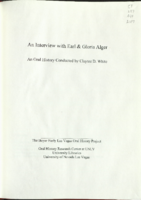
Transcript of interview with Earl and Gloria Alger by Claytee D. White, October 29, 2009
Date
2009-10-29
Archival Collection
Description
Earl and Gloria Alger were born in the early 1930s, met at the Mormon Church, dated in high school and have spent their entire lives in Las Vegas. Earl's story begins with his father arriving to take a construction job at the Boulder Dam. For a year he worked and saved to move his family from Utah to Las Vegas. The family lived on the Westside and Earl recalls he and his brother sharing a tent as their bedroom for a while. Gloria remembers growing up on Garcia Street in the downtown area. Her parents took her to a Liberace show for her 16th birthday, but other than that their lives were centered around the Mormon church. Her great-grandfather Torrel Lewis was one of the original pioneers from Salt Lake City. They describe the good old days of the "old Ranch", "Twin Lakes", and "frogging"; of the changed attitudes of working in gaming by the Mormon community and the more recent changes due to corporation leaders and increased traffic of the population growth.
Text
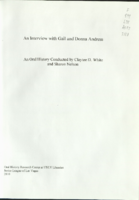
Transcript of interview with Gail and Donna Andress by Claytee White, November 26, 2008
Date
2008-11-26
Archival Collection
Description
The memories and recollections of Gail and Donna Hanley Andress provide a rare and fascinating look at the early days of Las Vegas. They arrived in the early 1930s and, except for relocations due to military service in World War Two, remained active citizens of the town until retiring to Nelson, Nevada, in 1987. Gail's careers spanned a number of occupations, from car dealerships to construction work, and Donna volunteered to serve in a number of community organizations, principally the Service League, the forerunner of the Junior League of Las Vegas. They insist that Nelson is not far from Las Vegas and have remained interested and supportive of many projects in both communities.
Text
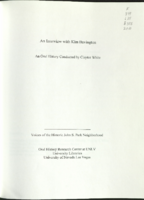
Transcript of interview with Kim Bavington by Claytee White, July 15, 2010
Date
2010-07-15
Archival Collection
Description
In 1964, Kim Bavington's parents moved to Las Vegas when she was six months old. Her father was an industrial designer and mother was an art instructor. In this interview she speaks of growing up in Las Vegas and the various locations where she lived over the course of years, including: eighteen years in Francisco Park, an apartment in Spring Valley, a first house in Green Valley and eventually a home that she and husband Tim Bavington, an artist, own in John S. Park. Kim earned a Fine Art degree from UNLV and worked at a sundry of jobs to support herself. She reflects on this and on how living in Paris, where she took art classes at Sorbonne for six months, dramatically altered her perspective of Las Vegas. Eventually a neighbor situation further changed her feelings about living in a gated community and she knew she wanted to move to what she calls "an old fashion neighborhood." The house search lead her and future husband Tim to John S. Park Neighborhood and a once "super Mid-Century Modem ranch" house. Their large five-bedroom house was built in 1963, has been restored to its original state and is furnished with 1950s furniture.
Text
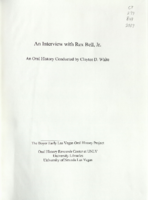
Transcript of interview with Rex Bell Jr. by Claytee D. White, March 2, 2010
Date
2010-03-02
Archival Collection
Description
Growing up on the Walking Box Ranch as the son of movie stars Rex Bell and Clara Bow, attending law school, work in Las Vegas, race relations, and owning a law practice.
Text
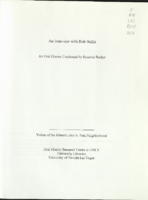
Transcript of interview with Bob Bellis by Suzanne Becker, June 19, 2007
Date
2007-06-19
Archival Collection
Description
Starting at a young age, Bob Bellis' parents instilled upon him the importance of being a good neighbor and a community advocate. He was raised in Pahrump and moved to Las Vegas circa 1984. A few years later, he was living in the John S. Park neighborhood where his deeply rooted tradition of community found a purpose—preserve a historic area of Las Vegas. He enumerates the downside of living in John S. Park, but quickly adds reasons for remaining as the neighborhood reinvents itself for the next generation. Bob has not been an idle resident and headed up the creation of the John S. Park Neighborhood Association starting in 2000. Bob touches upon the history of the community and its evolution to a more diverse profile. Yes, two homeless people were living in the backyard when he moved in, but John S. Park is not a crime-riddled place to live he explains. The more looming threat of high-rises is an issue that concerns him.
Text

Transcript of interview with Betty Blevins by Emily Powers, March 18, 2003
Date
2008-03-18
Archival Collection
Description
Betty Blevins was born in the small town of Berry, Alabama. She graduated from high school there in 1953 and then went on to nurses' training at the University of Alabama School of Nursing in Birmingham. She recalls the segregated wards, emergency rooms, and drinking fountains at the university hospital when she worked there in the fifties and early sixties. Betty's husband was hired at the Nevada Test Site as a journeyman electrician in 1963 and they moved to Las Vegas with their two children. Betty remembers living near Desert Inn Road and the Boulder Highway and taking her two older daughters to the Huntridge Theater on Charleston and Maryland Parkway, where they could see a movie and buy treats for fifty cents apiece. When Betty started working in Las Vegas as a nurse, there were only two hospitals, Sunrise and the old Memorial Hospital (now UMC). She was hired at Sunrise Hospital and describes the layout, recalls some of the surgeons she worked with, and offers up anecdotes of life in the O.R. Her third daughter was born at Sunrise as well. Betty eventually worked at Memorial and Valley View Hospitals, and ended up back at Sunrise. She recalls assisting during the first open-heart surgery with Dr. Ficus and the first corneal transplant with Dr. Shearing. Ms. Blevins describes the monumental changes in operating techniques and surgeon education, the installation of telephones in the O.R., the introduction of disposable sterile equipment, and the advent of computers and lasers. She recalls the first kidney harvest in which she participated, and shares examples of the humor that could be found in the hospital. She retired in the eighties and looks back on her long career with satisfaction.
Text
Pagination
Refine my results
Content Type
Creator or Contributor
Subject
Archival Collection
Digital Project
Resource Type
Year
Material Type
Place
Language
